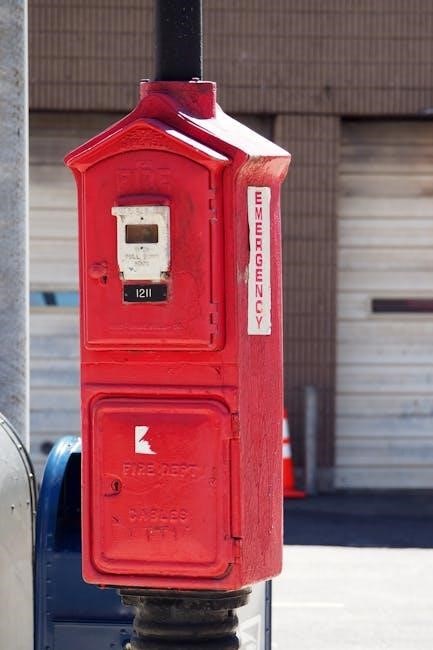Manual call points are devices used to trigger fire alarms, typically installed in public buildings and businesses, with a red housing for easy identification and use in emergencies always.
Definition and Purpose
A manual call point is a device that allows individuals to manually trigger a fire alarm in the event of a fire or emergency. The primary purpose of a manual call point is to provide a means for occupants to quickly and easily alert others in the building of a potential fire hazard. This is particularly important in situations where automated fire detection systems may not be able to detect a fire, such as in areas with high levels of smoke or heat. Manual call points are typically installed in strategic locations throughout a building, such as near exit doors, stairwells, and corridors, to ensure that they are easily accessible in an emergency. They are an essential component of a building’s fire safety system, providing a reliable and efficient way to alert occupants and emergency services in the event of a fire.
Locations for Installation
Manual call points are typically installed in various locations throughout a building to ensure easy access in the event of a fire. These locations may include near final exit doors, at the top or bottom of stairwells, and at periodic points down longer corridors or hallways. The installation of manual call points is crucial to provide a means for occupants to quickly alert others of a potential fire hazard; In public buildings, manual call points are often installed in areas with high occupancy rates, such as shopping centers, hotels, and hospitals. The specific locations for installation may vary depending on the building’s layout, occupancy, and fire safety requirements. By installing manual call points in strategic locations, building owners can help ensure a timely response to fires and minimize the risk of injury or damage. This is an essential aspect of fire safety planning.

Functionality of Manual Call Points
Manual call points activate fire alarms, alerting occupants and emergency services of potential fires quickly and effectively always in emergency situations requiring prompt action immediately.
Activation and Signaling
Activation of manual call points triggers a signal to the fire alarm control panel, which then sounds the alarm throughout the building, alerting occupants of potential fires. The signaling process is crucial in emergency situations, as it prompts immediate action to ensure safety. The signal sent by the manual call point is received by the control panel, which then activates the alarm, providing a clear warning to occupants to evacuate the premises. This process is designed to be quick and efficient, allowing for prompt response to emergency situations. The activation and signaling process is a critical component of fire alarm systems, and manual call points play a vital role in initiating this process, helping to prevent injuries and damage. The signaling mechanism is reliable and efficient, ensuring that the alarm is sounded promptly.
Emergency Protocols
Emergency protocols are initiated when a manual call point is activated, triggering a series of events to ensure occupant safety. The fire alarm system automatically alerts the fire brigade and other emergency services, facilitating a rapid response. These protocols are designed to be efficient and effective, minimizing damage and risk to people and property. The emergency protocols may include evacuation procedures, firefighting measures, and first aid responses, all of which are critical in emergency situations. The manual call point plays a vital role in triggering these protocols, providing a reliable means of alerting authorities and occupants to potential fires. By initiating emergency protocols, manual call points help to prevent injuries and damage, ensuring a safe and prompt response to emergency situations, and providing peace of mind for building occupants and owners alike, with a focus on safety and emergency preparedness always.

Installation and Requirements
Manual call points require proper installation and maintenance to ensure functionality and compliance with regulations always in place for safety reasons every time.
Fire Risk Assessment
A fire risk assessment is a critical step in determining the need for manual call points in a building. This assessment helps identify potential fire hazards and evaluates the risk of fires occurring. The assessment takes into account various factors, including the type of occupancy, building layout, and materials used in construction. Based on the assessment, recommendations are made for the installation of manual call points and other fire safety measures. The goal of the assessment is to ensure that the building is equipped with adequate fire safety measures to protect occupants and property. By conducting a thorough fire risk assessment, building owners and managers can ensure compliance with regulations and reduce the risk of fires. This assessment is typically conducted by a qualified fire safety professional.
Insurance and Design Recommendations
Insurance companies often require the installation of manual call points as a condition of coverage. They may also provide recommendations for the design and installation of these devices. A qualified fire system designer can help ensure that manual call points are installed in accordance with insurance requirements and regulatory standards. The designer will consider factors such as building layout, occupancy, and fire risk to determine the optimal location and type of manual call points. Additionally, the designer may recommend the use of specific products or models that meet insurance and regulatory requirements. By following these recommendations, building owners and managers can ensure that their manual call point system meets the necessary standards and provides adequate protection for occupants and property. This can also help to reduce insurance premiums and minimize the risk of non-compliance. Proper design and installation are essential.

Types of Manual Call Points
Manual call points come in various types, including indoor and outdoor models, with different features always available for specific applications and uses in emergency situations quickly.
Indoor and Intrinsically-Safe Call Points
Indoor manual call points are designed for use in standard environments, while intrinsically-safe call points are used in hazardous areas where explosive atmospheres may be present. These call points are designed to prevent ignition of flammable gases or dust, ensuring safe operation in potentially explosive environments. They are typically used in areas such as chemical plants, oil refineries, and other high-risk locations. The intrinsically-safe design ensures that the call point will not generate enough energy to ignite a flammable atmosphere, providing an added layer of safety and protection. Indoor call points, on the other hand, are suitable for use in offices, schools, and other non-hazardous environments, providing a reliable means of manual fire alarm activation. They are easy to install and maintain, with a simple and intuitive design.
Explosion-Proof and Hazardous Area Call Points
Explosion-proof and hazardous area call points are specialized devices designed for use in high-risk environments where flammable gases, vapors, or dust may be present. These call points are constructed with robust materials and designed to withstand extreme conditions, ensuring reliable operation in hazardous areas. They are typically used in industries such as oil and gas, chemical processing, and pharmaceutical manufacturing, where the risk of explosion is high. The explosion-proof design prevents the call point from igniting a flammable atmosphere, while the hazardous area rating ensures that the device can operate safely in areas with high concentrations of flammable substances. These call points are essential for providing a safe and reliable means of manual fire alarm activation in high-risk environments, and are often installed in conjunction with other safety devices to provide comprehensive protection. They are also designed to meet specific safety standards.

Specific Products and Models
Manual call points include various models like D9000 MCP with advanced features always available for fire alarm systems installation and use in different environments safely.
D9000 MCP Manual Call Point
The D9000 MCP manual call point is a device designed for indoor operation in fire detection systems, providing a reliable means to trigger fire alarms in emergency situations.
It is typically installed in public buildings and businesses, and features a red housing for easy identification and use.
The D9000 MCP is part of a range of manual call points that are powered by modern fire alarm technology, ensuring a strong defense against fires.
These devices are designed to be easy to install and use, and are suitable for a variety of environments.
The D9000 MCP manual call point is an important component of a fire alarm system, providing a simple and effective way to alert occupants and emergency services in the event of a fire.
It is a crucial element in ensuring the safety of people and property in emergency situations, and is an essential part of any fire safety plan.
The importance of these devices cannot be overstated, as they help to save lives and prevent property damage.
By installing manual call points in strategic locations, building owners and managers can ensure a swift response to fires, minimizing the risk of injury and damage.
Overall, manual call points are a crucial component of any fire safety plan, and their effectiveness is evident in their widespread use in public buildings and businesses.
Their simplicity and ease of use make them an essential tool in the fight against fires, and their importance will only continue to grow in the future.
As technology continues to evolve, it is likely that manual call points will become even more sophisticated and effective.

Leave a Reply